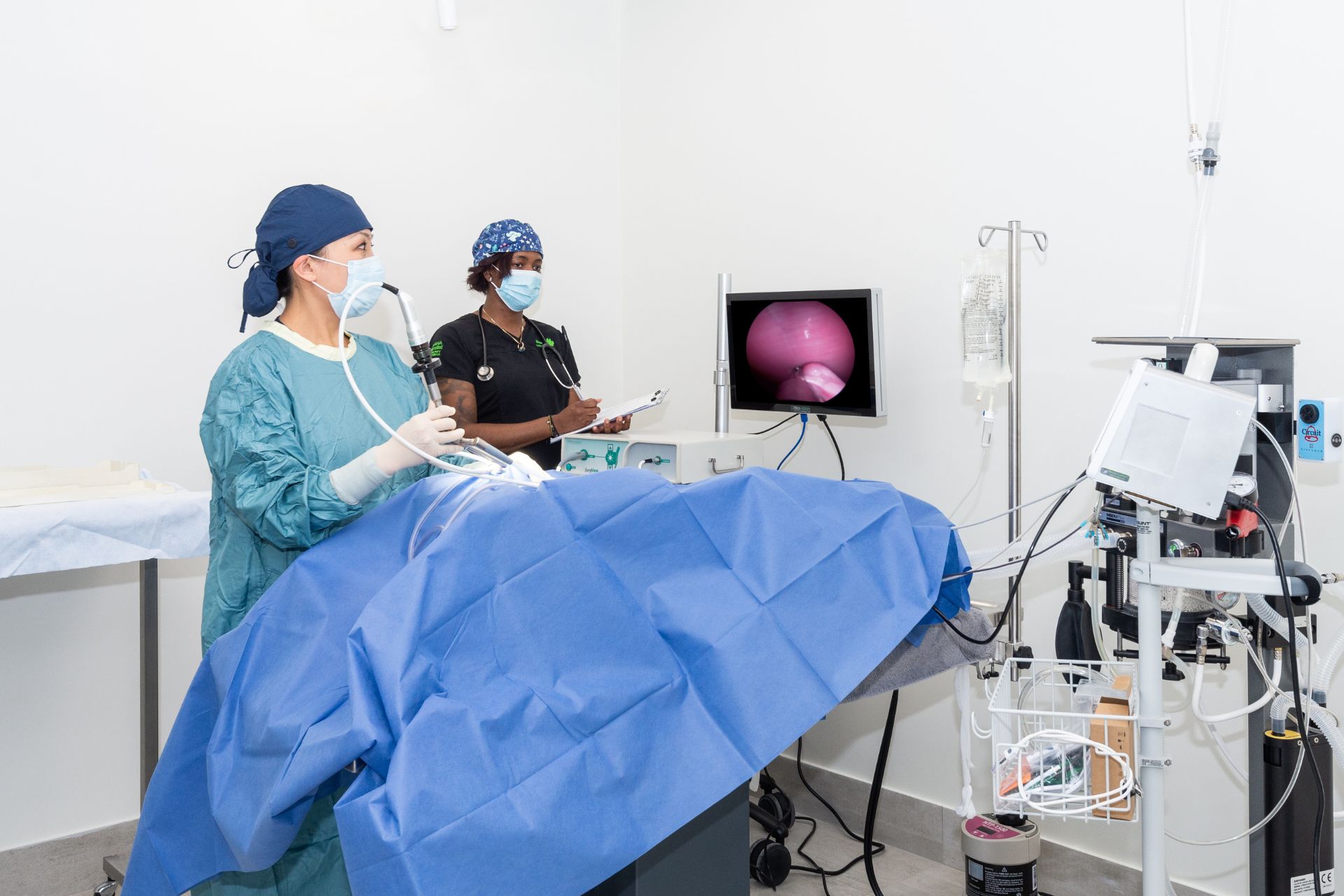Prophylactic Gastropexy: Preventing Gastric Dilatation-Volvulus

Prophylactic gastropexy is a surgery aimed at preventing the stomach from twisting on itself (a condition called gastric dilatation-volvulus) by securing the stomach to the abdominal wall. We recommend this procedure for dogs at highest risk for the condition (typically deep-chested large or giant breeds). There are a number of ways to accomplish a prophylactic gastropexy. We use a minimally invasive technique (laparoscopic-assisted gastropexy) that involves a single, small incision into the abdomen and the use of a laparoscope outfitted with a camera to see inside the abdomen.
What is gastric dilatation-volvulus (GDV)?
GDV is a rapidly progressing, very painful, life-threatening condition in which the stomach fills with gas, fluid, and/or food (a process called dilatation or “bloat”) and becomes twisted on itself (volvulus), preventing those stomach contents from escaping. The resulting pressure within the stomach compromises blood flow to stomach tissues. Disruptions in blood supply lead to tissue death and a rapid drop in blood pressure, all of which damage multiple organ systems (liver, kidneys, heart, and brain). Without emergency surgery and treatment within a few hours of volvulus, GDV is fatal. Even with emergency surgery, the condition can be fatal depending on the level of compromise at the time of presentation.
A prophylactic gastropexy (surgically securing the stomach to the body wall to prevent it from twisting) is the most effective means of preventing GDV.
Why choose laparoscopic-assisted gastropexy?
Compared to traditional surgery that involves entering the abdomen through a large incision, laparoscopic-assisted gastropexies have the following advantages:
- Less invasive – a single, small incision of about 5 cm is made rather than the larger (15-25 cm) incision required for a traditional gastropexy
- Less bleeding and pain – with a smaller incision comes less trauma to tissues and less bleeding and pain
- Shorter time under anesthesia
What’s involved in a laparoscopic gastropexy?
Once a patient is placed under general anesthesia, a small incision is made on the right side of the abdomen just below the rib cage. CO2 gas is then introduced through the incision to lift the body wall away from the internal organs, creating a domed effect so that those organs can be easily visualized. A laparoscope is introduced into the abdomen. The stomach is grasped with forceps and brought to the incision. The outermost layer of the stomach is then surgically attached to the innermost layer of the abdominal wall muscle. The attachment anchors the stomach in place and prevents it from twisting on itself in the future.
Our patients recover in our state-of-the art temperature-controlled Casco enclosures equipped with special recovery lighting to ensure a warm and restful recuperation from anesthesia.

Does my dog need a prophylactic gastropexy?
GDV has a number of risk factors rather than a single specific cause. The most common risk factors are outlined below. Your veterinarian can help you decide whether your dog would benefit from a prophylactic gastropexy.
- Breed – The overall incidence of GDV in large and giant purebred dogs is reported to be 15.7% and 8.7% respectively. Breeds at greatest risk for developing GDV include the Great Dane, Irish Setter, Standard Poodle (purebred and crosses), Weimaraner, and Rottweiler. Of these, the Great Dane has the highest incidence of GDV (40%) over its lifespan. Other breeds that are also at risk include the Akita, Bernese Mountain Dog, Bloodhounds, Boxer, Collie, Doberman Pinscher, German Shepherd, Great Pyrenees, Greyhound, Gordon Setter, Irish Wolfhound, Mastiff, Newfoundland, and Saint Bernard.
- Anatomy/Body Condition – large and giant breeds with deep chests and thin or lean giant breeds.
- Personality Traits – dogs that are hyperactive/high-strung or fearful
- Dietary Factors – dogs that eat large amounts of food very quickly (and especially when fed only once daily); those that eat out of raised food bowl
- Other – a direct relative with history of GDV, advancing age (middle-age to older), previous history of bloat (dilatation) or gastrointestinal disorders, and other factors

What’s the success rate of prophylactic gastropexies?
A very small percentage of dogs that have had a prophylactic gastropexy can still experience bloat (dilatation), but their risk of experiencing a volvulus (a twisting of the stomach) is reduced by 95%.
Are there any complications?
Some minor swelling at the gastropexy incision site occurs in some individuals and typically resolves on its own. A small percentage of dogs vomit post-operatively. This usually resolves by feeding smaller meals for a few days.
How long will my dog be in hospital?
Your dog will be admitted (fasted) in the morning and will return home the same day in the evening.
How long is the recovery period?
Your dog’s activity will need to be restricted for about 2-3 weeks days following surgery to ensure that incisions heal uneventfully.
Can my dog have a gastropexy performed at the same time as spay or neuter surgery?
Yes. The two procedures can be performed together and avoids having to place your pet under general anesthesia a second time.
Does a laparoscopic gastropexy cost more than a traditional surgery?
Laparoscopic surgery costs a little more than a traditional prophylactic gastropexy because it requires specialized training and highly specialised equipment that includes a high-end camera and video screen.
Is a laparoscopic gastropexy covered by insurance?
Most basic plans don’t cover prophylactic surgery regardless of whether it’s done laparoscopically or using a traditional method. Check with your insurance provider to see what your plan covers.
Can my dog have a gastropexy performed at SOVH if I’m not a regular client there?
Absolutely! We recognize that there aren’t many hospitals that offer this service, and we’re happy to help. We’ll need medical records to assess the health of your dog, and we’ll share our surgical records with your regular veterinarian.



